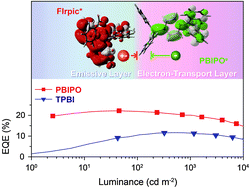Phosphine oxide-jointed electron transporters for the reduction of interfacial quenching in highly efficient blue PHOLEDs†
Abstract
A series of benzimidazole–PO hybrids, PBIPO, DPBIPO and TPBIPO, with different configurations of phosphine oxide (PO)-bridged 2-phenylbenzimidazole (PBI) groups, demonstrate an effective charge–exciton separation (CES) strategy for electron-transport material (ETM) design aimed at interfacial triplet-polaron quenching (TPQ) suppression in hole-predominant phosphorescent organic light-emitting diodes (PHOLEDs). The electronic states of these materials are well-controlled by virtue of their insulating and electron-withdrawing phosphine oxide joints. Their equivalent frontier molecular orbital energy levels (−2.7 and −6.4 eV) and triplet states (3.0 eV) give them identical good electron-injecting/hole-blocking abilities and effective exciton diffusion suppression, establishing a correspondence between electron mobility and interfacial TPQ effect, and the device performance of these ETMs. Stronger interactions between TPPO groups and blue phosphor iridium(III) bis(2-(4,6-difluorophenyl)-pyridinato-N,C2′) picolinate (FIrpic) give rise to the optimized orientation of unsymmetrical PBIPO on the emissive layer (EML) to separate its charged moiety from the EML interface, effectively suppressing interfacial TPQ. Consequently, PBIPO endows its conventional FIrpic-based blue device with state-of-the-art efficiencies of 47.3 cd A−1, 36.0 lm W−1 and 22.2%, which are two- and three-fold those of the common ETM TPBI and its analogue DPBIPO, with a two orders of magnitude higher electron mobility. At 1000 cd m−2, the efficiencies of PBIPO-based devices still remained at 43.5 cd A−1 and 20.1%, making PBIPO among the most efficient high-energy-gap ETMs to date and manifesting the effectiveness of the molecular CES strategy for interfacial TPQ suppression.


 Please wait while we load your content...
Please wait while we load your content...